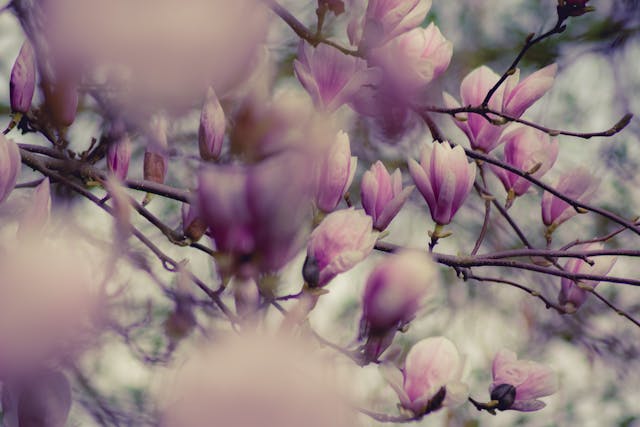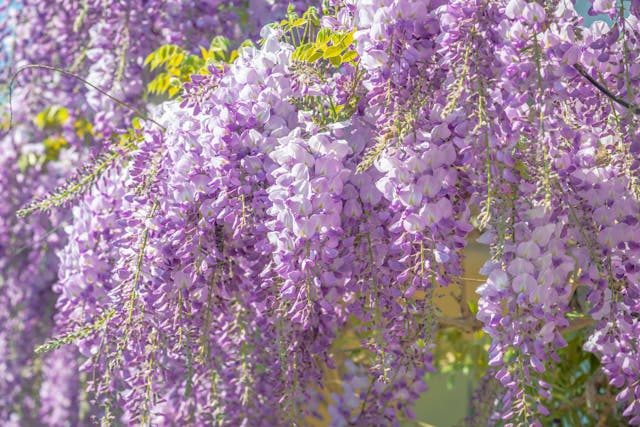Designing your garden with fragrance will add dimension during the day as you walk through the scented grass and leaves, and at night when nighttime fragrances perfume the night air.
No matter the size of your outdoor space, big or small, terrace or balcony, turning it into an aromatic garden is one of the most beneficial health garden ideas you can adopt.
Pleasant aromas improve our mood and therefore contribute to our well-being. A recent scientific study published in the journal Progress in Neurobiology shows that smell, among the five senses, can improve brain function.
Scientists say that when we inhale, aromatic molecules immediately react from the oldest evolutionary part of the brain – the hippocampus. It is the part that stores all our memories and emotional responses to external stimuli.
If you want to know how to create a fragrant garden, where to start?
How to make a fragrant garden?
When you plan to create a fragrant garden, think about what you want from it.
“Do you want a relaxing or stimulating space? Or a combination of both?’ says Mark Emery, education and training officer at the horticultural health charity. It depends a lot on your personal sensitivity to different smells.’
Floral, sweet, musky, earthy, spicy, reminiscent of a favorite childhood garden or a sunny holiday, the plant has a wild variety of aromas. “For example, you may prefer the soft scent of shrubs and find the fragrance too sweet,” says Mark. “Or you like strong floral scents and want more of them.”
The quantity and condition of aromatic plants in an aromatic garden is important. If you like the idea of a relaxing garden, having lots of different aromatic plants can be very powerful. Also, think about the proximity of fragrant plants to each other and how the wind will carry the fragrance through your fragrance garden.
And most importantly, plan your fragrance garden to enjoy it. Catherine Clancy, founder of Catherine Clancy Garden Design: “Always try to include some kind of seating in the middle of your fragrant plants so that you can rest, relax and enjoy the fragrance after a busy day can”.
Magnolia
magnolia tree in the street
Magnolias, small trees or large shrubs that bloom in March/April are a good sign of spring. Acidic soil is preferred over well-drained soil so that it does not grow so large that it becomes unmanageable.

“I love the stemmed Susan Magnolia because of its fragrant purple-pink flowers that attract bees and other pollinators in the spring, providing a much-needed source of nectar early in the season,” says garden designer Emily Crowley-Wroe. . Founder of April House Garden Design. It is best to place it in a slightly sheltered location in the sun/part to protect it from wind and cold. For a sensory experience, plant it near an entrance/exit, walkway or living room where you can catch the musky perfume in the air.’
mixed herbs
Herbs in terracotta pots on wooden garden shelves
There are many herbs that can be grown together in an herb garden idea, and these edible plants provide delicious benefits. “With most herbs, you need to plant them in full sun,” says Emily. “Look as close as possible to the kitchen or living room, where you can brush the leaves and release a wonderful aroma.”
Some good herbs recommended by Emily for fragrance include citrus green marjoram, especially fragrant marjoram, which gives off its strong scent in summer, and fragrant gray-green leaves with purple-blue flowers in early summer pleasure (Salvia officinalis Purpurascens). . .
He also likes fennel (Foeniculum vulgare): “Fennel dies in the winter, but soon sprouts again with fresh, soft green leaves. The leaves are fragrant when rubbed, and the seeds after the flowers are fragrant. It’s tall, so use it as a foil for other plants, as a centerpiece or as a background Fennel likes to self-sow, so lift the seedlings or place them where they don’t mind sprouting
Evergreen rosemary, whose needle-leaved leaves are used to flavor roasts, stews and breads, is another recommended herb: “Depending on the variety, rosemary may need protection in harsh winters, but it’s purple-blue from mid-spring. until the beginning of summer with color k.
Roses
There are so many beautiful scented roses, it’s hard to choose the best suggestion for a scented garden. But a good fragrant rose for beginners is David Austen’s Graham Thomas, says Guy Barter, head gardener at the Royal Horticultural Society: “It has double deep yellow flowers and is fragrant, so you can have it all season.” Will get a variety of colors throughout. If dead, the bow will usually grow to about 1.2m.
For climbing roses, Barter offers a small, fragrant deep orange semi-double from David Austen and Super Elfin, a rambler with small red flowers and a delicate fragrance.
Salvias
purple sage
This decidedly basic summer garden idea might not be an immediate choice for a scented garden, but everyone is smart about releasing fragrance, says Emily. “One of my favorites for its color (it’s a dark plum color) and scent of sweet mint and blackcurrant is Salvia x jamensis ‘Nachtvlinder’ (available at Sarah Raven). Drizzle along a walkway or flower pot so you can read it. It likes full sunspots.
Emily recommends protecting this sage with mulch or wool in winter, as it can die in severe frosts, so take cuttings in April, August or September for insurance.
Wisteria
Wisteria grows around the iron gate.
“My number one climber for beautiful scent, color and drama is wisteria (Wisteria Sinensis Prolific),” says Emily. Wisteria has a romantic air, especially when receiving morning and evening sun. I put mine on the front wall of the house and around my bedroom window so that when I open the window in the morning I can enjoy the smell first thing.

Blue-purple to white wisteria with a sweet to musky aroma are strong plants, but they need support unless you have a compact potted variety, so keeping purple plants on the wall is recommended for growing. or in a building. ideal. It also needs pruning (twice a year) to ensure good rebloom, advises Emily, and likes full sun and moderately fertile soil.
Daphne winter
Daphne odora (Winter Daphne) has the most beautiful scent; In my opinion, the cutest flowering shrub! Tom Murphy, Principal and Lead Designer of Compass Park Design.
“It’s a deep floral scent, but with a hint of citrus that elevates it from more typical garden scents.”
Winter Daphne likes full sun in a sheltered spot. Small pink flowers appear from winter to spring. “So it’s guaranteed to lift your spirits on a cold, wet day,” adds Tom. “I like to plant winter laurel or put it in a pot in front or behind the door so you get a kick every time you leave the house – magical.”
Tips for creating a fragrant garden
1. Plant up pots
courtyard garden with wood panelling and bistro set
An instant way to bring fragrance into your garden is to plant up pots with sweet-smelling plants. Container garden ideas are also ideal if you have limited space, says gardener Sarah Raven: ‘Scented leaf pelargoniums such as ‘Attar of Roses’ look utterly fabulous in pots, therefore an absolute must-have in small spaces like patios or balconies.’
Not only does this pretty pelargonium have a delicious scent, it’s edible too, and makes most divine cordial and herbal tea, adds Sarah: ‘Both are favourites here at my home in Perch Hill [her garden in Burwash, east Sussex].’
2. Line a path with herbs
driftwood boardwalk garden path with plants
A garden path idea lined with herbs is a lovely – and practical – feature to include when you’re planning a fragrant garden. Use home-grown fresh herbs in cooking, or simply crush leaves in your hand to release uplifting aromas as you pass by.
Choose hardier herbs such as mint, rosemary and thyme, which can withstand frosty ground temperatures. Or, grow more tender herbs, such as lemon verbena, in pots or at the front of raised planters along pathways, Catherine suggests, so their scent is released when you brush past them.
‘Golden marjoram is fabulous for bright and zesty lime year-round colour and scent and is particularly fragrant in the summer,’ says Emily. ‘I plant it in containers, raised beds and in the front of borders where it fills gaps quickly, provides colour and scent.’
4. Include arches of scented climbers
rose arch with climbing roses above a bench
One of the most relaxing garden ideas for a fragrant garden is to include arches of scented climbers which will immerse you in scent. “Place fragrant climbers over pergolas and in archways near entrances to the garden so their scent will invite you in,” says ‘Immersive fragrant planting either side of a pathway, perhaps with climbing roses or sweet peas, is a fabulous way to enjoy the experience.’
5. Let scented plants scramble over a shed
Wall beside raised beds with a stainless steel barbeque inset, roses and fig growing up sheds. Susan and Henry Parker’s garden at their four bedroom Victorian house in Fulham, London.
Honeysuckle is a wonderfully vigorous climber for a fragrant garden; the scent can range from soft and soapy to rich and luscious, depending on the variety.
It loves a spot with sunlight and light shade. ‘For this reason, growing honeysuckle up a garden shed or outbuilding provides the perfect environment for blooming,’ says Laura Juniper, spokesperson for Garden Buildings Direct . ‘The hardy honeysuckle plants can tolerate a range of weather conditions throughout the year.’
Or, if your fragrant garden has a hot and happening colour scheme, what about the vibrant orange shades of a Trumpet Vine plant? ‘This is a perfect choice for growing up a garden building to provide some colour and fragrance to the space,’ says Laura. ‘The eye-catching plants are sturdy enough to withstand winter conditions and then bloom again in spring. The warmer the temperature, the more profusely the Trumpet Vines will grow and continue to bloom.’
5. Don’t forget foliage
Two potted bay trees by the front door of a white house
Foliage is an important part of any fragrant garden. From growing a bay tree in a pot for kerb appea, to the shrubby curry plant (Helichrysum italicum) which will thrive in poor soil in full sun with pretty yellow flowers and delicate silvery fronds bringing a peppery perfume to the air, there’s fragrant foliage for every spot.

6. Create scent zones
A small curved bench at the RHS Chelsea Flower Show, bookended with two trees
You might like to include small zones of scent in your fragrant garden that support different purposes; if you’re keen on Zen garden ideas, perhaps one area could focus on calm and peace, whilst another area stimulates the senses with zesty tangs.
Try and group together scents that work to support each other. This will intensify the aromatic atmosphere. Also, some areas of the garden may be better-suited to fragrant plants than others. ‘Growing aromatic plants in a protected region of the yard may help control the smell,’ explains Mark. ‘If you’re using aromatic plants in a big border, place smaller ones at the front so you can enjoy them as you go by.’
